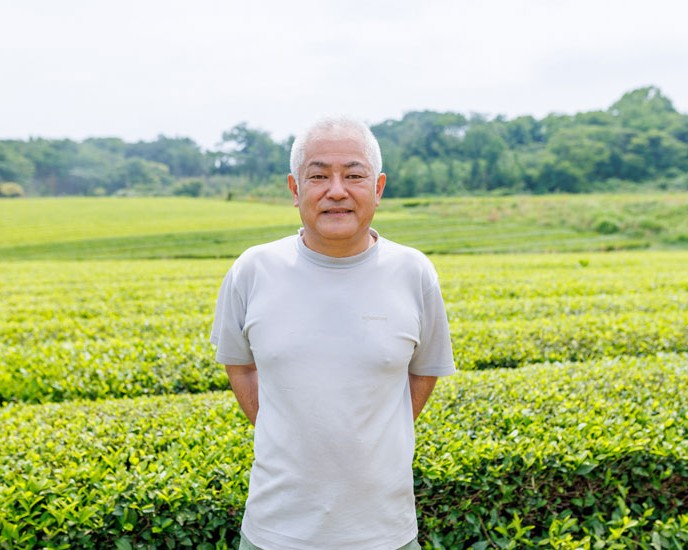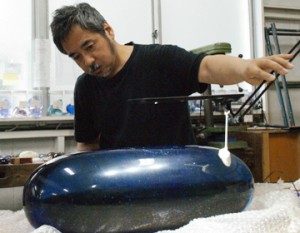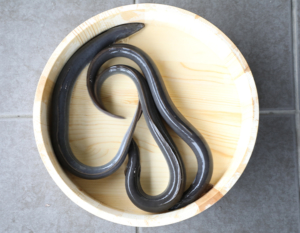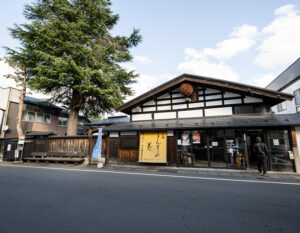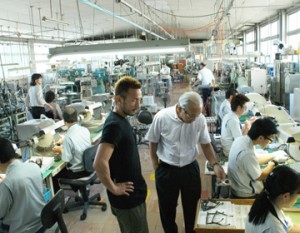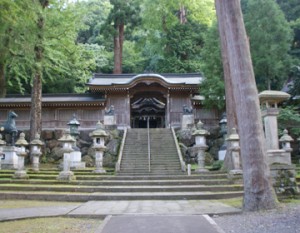In Tottori Prefecture, which is not famous for its tea production, there is a tea farm that produces delicious black tea. It is the Jingamae Tea Production Cooperative. In winter, the tea grows strongly even though it is covered with snow, and it has a reputation for being sweet. In addition, the black tea grown naturally, without the use of pesticides or organic fertilizers, has been attracting attention in recent years as Tottori Prefecture’s “jiko-cha” (local black tea).
Jingamae area at the foot of Mt.Daisen.

Daisen-cho is located in western Tottori Prefecture. The Jingamae area is located in the center of the town. The name “Jingamae” comes from the fact that in 1333, a military commander from Hoki-koku established a camp here to protect Emperor Godaigo. To the north is the Sea of Japan and to the south is Mt. Daisen, the highest mountain in the Chugoku region, and there is a large difference in temperature between daytime and nighttime. The black-bok soil, formed by piling up volcanic ash from Mt. Daisen, has excellent drainage and is acidic, making it suitable for tea cultivation.
There is a tea grower in the Jingamae area who has been attracting attention for his tea production. They are Mr. Hashii and Mr. Hirasawa of the Jingamae Tea Production Cooperative.
The history of tea production at Jingamae Tea Producers Association

Even within Tottori Prefecture, there are only a few tea farmers, and most of them grow varieties of tea used for green tea and sencha. In Japan, tea has a strong image of being grown in places with warm climates, such as Shizuoka and Kagoshima prefectures, but they were inspired by someone who was growing tea in a neighboring town and started growing it in the Jingamae area as well.
He says, “It seems that tea has been grown here since around the 1965’s. There were many more tea farmers then. There were many more tea farmers back then, and they all decided to form a cooperative and grow tea together, which led to the construction of a processing plant in 1978. Now we manage three hectares of tea fields, and there are only two members of the cooperative besides myself,” he says.
Because they are not large-scale farmers, it is difficult for them to manage their tea fields, and their yields are limited. He also thought that differentiation was necessary to promote the tea of Tottori Prefecture, which is not well known. Therefore, about 20 years ago, they adopted organic farming without using pesticides or chemical fertilizers, and obtained JAS organic certification, a national standard that only certifies fields that have been free of pesticides and chemical fertilizers for more than three years, and began delivering their products as an organic tea farm.
Encounter with Tea Making

The Jingamae Tea Production Association did not originally produce black tea, but they encountered the possibility of black tea production when someone advised them to do so. It was a comment from Kazuki Fujiwara, chairman of the “Black Tea Association,” a group of tea lovers in Tottori that started its activities in 1993. He said, “You can make black tea from ordinary tea leaves, so why don’t you try it?”
In fact, there are various types of tea, such as green tea, hojicha, and oolong tea, but the difference between them is not based on the variety grown but largely on the processing method used after harvesting.
Green tea, which is the most widely produced tea in Japan, is also called unfermented tea, and is generally fire-roasted, such as steamed or roasted, after the new tea leaves are picked. This is because if raw tea leaves are left as they are, fermentation will begin due to the action of oxidative enzymes. Fermentation is suppressed by repeatedly heating and cooling the tea leaves while they are fresh as much as possible, and the moisture content is lowered by rubbing and drying.
Black tea, on the other hand, is a fermented tea and is characterized by the fact that it is not steamed after harvest. The first step is a process called “wilting” to remove the water content without heat. The leaves are then blasted with air to reduce the amount of water in them by about half. After that, the leaves are rubbed to gradually promote oxidative fermentation. This process changes a type of polyphenol contained in the tea, giving it a unique aroma.
The tea leaves are then dried at the right time to complete the process.
Mr. Hashii and his colleagues, who were thinking of differentiating their tea from other tea gardens due to the small production volume, decided, “If we can make black tea, let’s try it,” and started producing black tea by using varieties of tea that had been grown for green tea.
Gradually gained recognition through trial and error

The varieties grown by the Jingamae Tea Production Cooperative are “Yabukita,” “Hokumei,” and “Okumidori. Benihikari” and ‘Kurasawa’ are also grown as varieties suitable for black tea.
Benihikari, in particular, is called “Beni-kei” and contains Assamese tea leaves, which are considered suitable for black tea, in its breeding process.
When they first started producing Benihikari tea, they did not have any specialized machines, so they had to customize their own machines for green tea while researching production methods, and went through a process of trial and error. Gradually, they were able to produce tea leaves of stable quality and became the talk of the town for their organically grown, domestically produced black tea. They also introduced tea machines and increased the ratio of tea production.
The resulting tea is now sold at roadside stations and local supermarkets under the name “Tottori Organic Black Tea. In addition, the tea is gaining recognition as it was ranked 9th out of more than 1,000 black teas produced in Japan in the “Domestic Black Tea Ranking” published by the Nihon Keizai Shimbun in 2023.
Tottori organic black tea, made from yabukita, which is also used for green tea, is gaining popularity for its low astringency and moderate sweetness.
Toward Natural Cultivation for Safer Drinking

In addition, in the last few years, the company has switched from organic to natural farming. Compared to organic farming, which uses naturally occurring fertilizers such as animal manure, natural farming uses no fertilizers at all. However, the black box soil of Mt. Daisen and the difference in temperatures have increased the flavor of the grapes.
Although weeding is time-consuming because weeds cannot be suppressed, the couple smiles as they say, “We can do our best when we know that everyone can drink our wine with peace of mind.
The National Black Tea Summit, which started in Tottori, Japan

One of the reasons why Tottori has come to be known as a local black tea is due in large part to the “National Locally-Grown Tea Convention”. Ji-chi-kocha” refers to black tea produced by taking advantage of local ingredients and characteristics, similar to locally brewed sake and beer.
In fact, the National Locally-Grown Tea Convention began in Tottori Prefecture.
From the Meiji period to the Showa period, black tea was produced in Japan and was also an export product. However, after that, it could no longer compete with foreign black tea and disappeared from tea production areas in Japan. Mr. Fujiwara, the chairman of the Black Tea Association, called for the production of black tea all over Japan, and at his suggestion, the Jingamae Tea Production Association started producing black tea.
The first Ji-Kocha Summit was held in Nawa-cho (now Daisen-cho), Tottori Prefecture, because it is a black tea-producing region and the founder, Mr. Fujiwara, lives in the same prefecture.
The Ji-Kocha Summit brings together producers of local black tea from all over Japan to connect tea lovers and tea producers and to revitalize the local community. The event has become an event that attracts thousands of visitors through a series of activities such as comparing local black teas from different regions of Japan and publicizing the local black tea map that shows the number of tea-producing regions. The Jingamae Tea Producers Association’s black tea has also become known to black tea fans nationwide through its participation in the summit.
We want to inherit a tea that can only be made in the camp structure

With no other tea growers besides Mr. Hashii and Mr. Hirasawa, we recruited new producers of local black tea, and one of them applied for the job because he wanted to promote local black tea. Mr. Kitaoka is an I-turner from Osaka. Mr. Kitaoka, who used to work for a trading company, and his naturally grown black tea are now considering entering it in overseas tea fairs and exporting it in the future.
The number of producers is decreasing and there are only a few of us left, but I want to keep the name Jingamae. I want to preserve the Jinkou name, even if in a small way, so that the tea will be recognized as a tea that can only be found here. We would be happy if we could export our tea and make more people aware of it,” says Hirasawa.
The production of local black tea started from a small tea plantation. The taste of this tea will continue to attract many people in the future.



